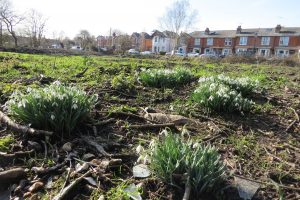Fen defenders
March 8, 2018
In December 2016 residents on the edge of Winchester had a grumble about the state of the waste-ground in front of their homes. But what began as a casual chat became a huge community effort to restore the local fen for wildlife.
It’s fair to say that Clausentum Fen, a fragment of the Itchen Valley ‘lowland fen’ ecosystem, has not always been looked after. The brooks and channels of the river Itchen south of Winchester have been relocated and managed since Roman times for drainage and irrigation, for energy in the form of water mills and to create meadows for grazing. For much of the medieval period this soggy patch of ground belonged to the church and by the 18th century expensive drains had been installed to turn it into a water meadow – producing rich grass for lambing.
The name Clausentum was chosen by Edwardian developers – it means ‘enclosed’ and is taken from a Roman settlement which once sat in a river bend further downstream. But though houses were built opposite the fen the site itself was considered too wet for housing.
“When we moved here 30 years ago it was still quite an interesting spot,” says Marcus Swalwell, one of the neighbours who joined that first conversation. “But we’ve gradually seen it disappear, invaded by bamboo, overgrown and fly-tipped upon.”
In 2003 another neighbour, Mike Gibbons, applied to have the area designated as a Site of Importance for Nature Conservation where snipe, linnets, reed bunting, bullfinches and spotted flycatchers could be seen. That year Hampshire County Council obtained a 999-year lease from the developers who own it to hold the land as ‘a nature conservation area, general woodland and meadowland.’

Today the site is about as far west as you can go and still be in the South Downs National Park. A green finger reaching into the city and, it turns out, a spot beloved by the community. “We decided to begin with a work party to clear the bamboo, with permission from Hampshire County Council, and were expecting six people to turn up so were surprised when 25 volunteers came out to work together. We cut down about five thousand stems of bamboo covering the size of a tennis court.” The Clausentum Fen Conservation Group was born.
Then Rob Nicholls, the South Downs National Park’s local ranger, got involved. “Rob was great,” says Marcus, “he gave us lots of advice and information about all the different people we could turn to for help and advice.” From conservation to monitoring and hydrology more than thirty different experts have helped the group put together a management plan and begin work.
The National Park Authority’s Sustainable Communities Fund contributed £2,000 for contractors to remove trees that were shading the streams and drying out the Fen. This has also helped to open up views across to St Catherine’s Hill. The group have also been experimenting with scraping and baffles to increase the water flow across the site. As a result, they’ve already seen an increase in river fly – a good indicator of water health and a food source for fish and birds. “It’s going to be a perfect habitat for water voles,” enthuses Marcus.
Students from Winchester College helped with clearing the main incoming water channel and there are two other local schools just around the corner. Detectorists who surveyed the excavated channels discovered Roman and medieval coins and a horseshoe from the time of the Black Death in the 14th century. The group hopes to be able to host educational visits for local children’s groups.
Managing access is one of the challenges the group faces. The northern half of the site boasts one of the most beautiful beech trees and brook side clearings that you will ever see, and the plan is to keep this part of the site accessible to the public. The southern half of the site will always be visible but may need to be protected for wildlife. Over winter the reworked fen has looked quite sad and bare in parts, although flag iris and snowdrops have started to show through and the area has been reseeded so will become greener as the weather warms up. Goat willow, hawthorn, blackthorn, guelder rose, native dog wood and bramble should also grow quickly and restore shrub habitat across the site.
There’s still a lot of work to be done but for now it’s time to appreciate their achievements. “This time last year I knew nothing about conservation,” says Marcus. “Now I want to stop and appreciate all the things I’ve learned and help nature take its course.”
Marcus handed over the chair of the Clausentum Fen Conservation Group to Marian Hollingsworth & Jonathan Sleath in February 2018.
For more information about the project visit www.clausentumfen.co.uk
